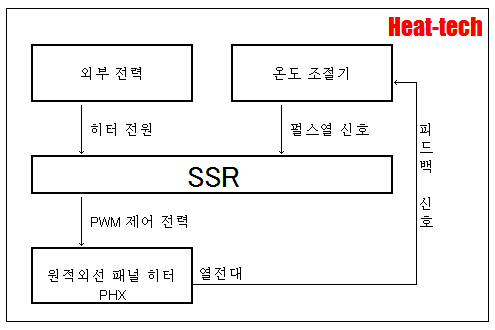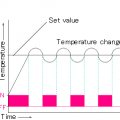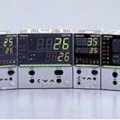
SSR (Solid State Relay)은 반도체로 만들어진 릴레이 입니다.
■ 기계식 릴레이의 특징
① 전압 출력 전압에서 전류에서도 동시에 제어 할 수있다.
② 전류 출력 전압에서 전류에서도 동시에 제어 할 수있다.
③ 교류 출력 교류에서도 직류에서도 동시에 제어 할 수있다.
④ 직류 출력 교류에서도 직류에서도 동시에 제어 할 수
⑤ 노이즈의 영향을받는 것은 거의 없다.
⑥ 노이즈를 코일 절연하고 차단 할 수있다.
⑦ 내열성이 높다.
⑧ 쉽게 자기 유지 회로가 짤.
등의 수많은 장점이 있습니다.
■ 기계식 릴레이의 단점
① 코일에 유도 기전력이 발생하는 바이 패스 회로를 설치하여야한다.
② 코일로 동작하므로 입력 후 출력이 발생하기까지 지연이 생긴다.
③ 접점은 판 스프링 때문에 금속 피로에 의한 수명이있다. (기계적 수명)
④ 접점에 아크가 발생하여 접점이 저하한다. (전기적인 수명)
⑤ 접점에 아크가 발생하여 노이즈가 발생할 수있다.
등의 단점이 있습니다.
■ SSR의 특징
반도체 릴레이 히터 컨트롤 기계식 릴레이 문제를 해결했습니다.
① 반도체 회로의 히스테리시스 성 코일에 비해 훨씬 작다.
② 또한 유도 기전력이 발생하지 않기 때문에, 입력 회로가 간단해진다.
③ 접점이 존재하지 않기 때문에 노이즈 대책이 불필요하게된다
④ 접점이 존재하지 않기 때문에 수명이 길다.
는 많은 장점이 있습니다.
■ SSR의 단점
① 반도체 소자는 반드시 전압 강하 (온 저항 및 순방향 전압 강하)가 부하 전류가 커지면 발열을 무시할 수 없습니다.
②5A 정도의 부하 전류는 고작 10W 정도의 발열량을위한 간단한 방열하면됩니다. 그러나 모터와 히터의 개폐 용도로는 50A 및 100A는 전류 값 때문에 발열은 무시할 수없이 강제 통풍 냉각 및 대형 히트 싱크가 필요합니다.
■ SSR의 응용
SSR은 주로 PWM하는 제어 방법으로 사용됩니다.
PWM (Pulse Width Modulation)는 고속 스위칭 전력을 제어하는 방식입니다.
정전압 입력에서 고속 펄스열을 켜거나 일정한주기를 만들어 온 시간 폭 (듀 – 티 비율)을 변화시킵니다.
유사하게, 뒤 – 티 비율을 전압비로 본다 제어 방식을 PWM 제어라고합니다
 HEAT-TECH 최선의 기술 온라인(on-line) 샵
HEAT-TECH 최선의 기술 온라인(on-line) 샵 









